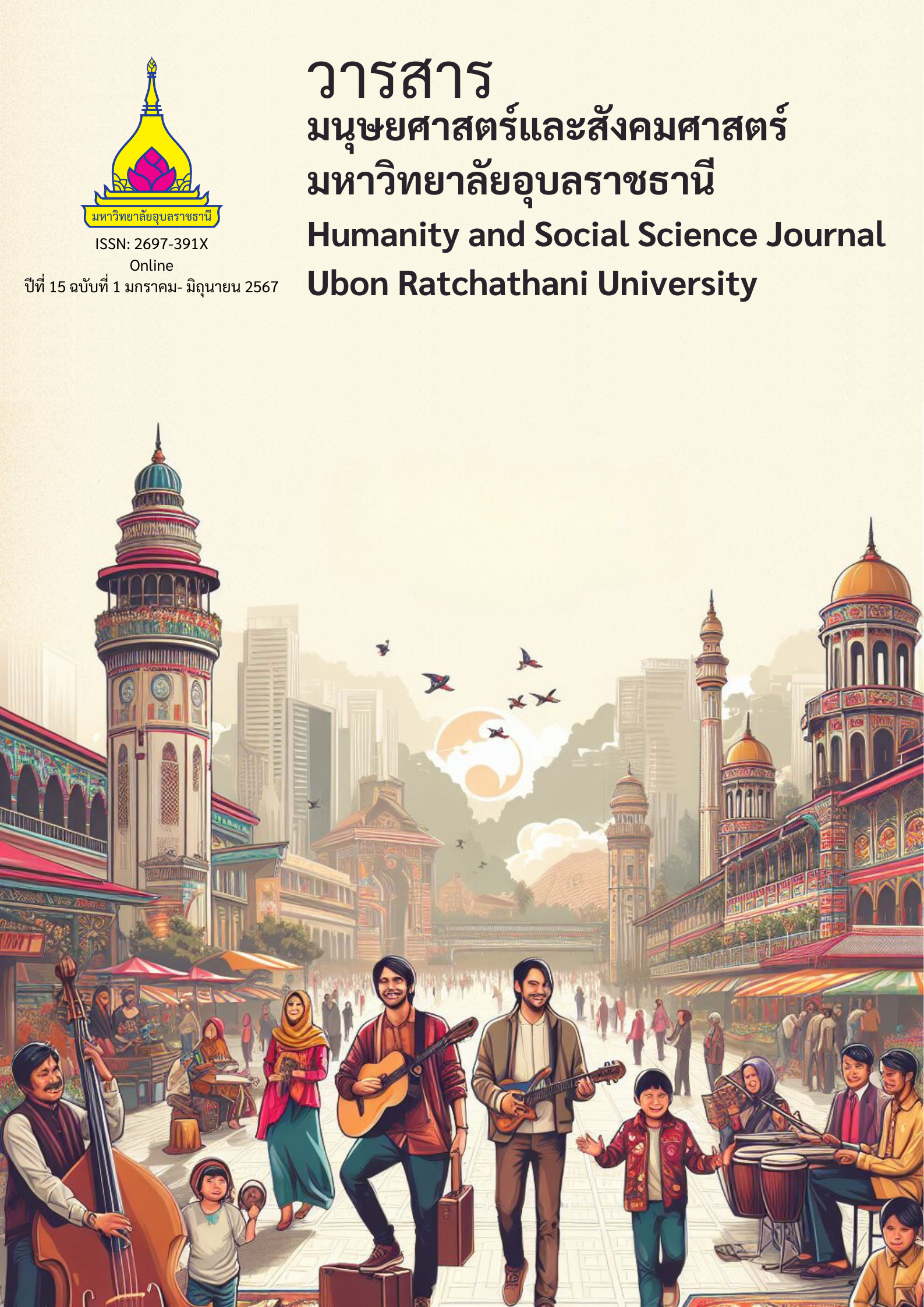ภูมิทัศน์ทางภาษาของป้ายธุรกิจที่ ‘กาดกองต้า’ จังหวัดลำปางกับความเป็นพหุวัฒนธรรมที่หายไป
Main Article Content
บทคัดย่อ
งานวิจัยนี้มีวัตถุประสงค์เพื่อศึกษาการปนภาษาบนป้ายธุรกิจที่กาดกองต้า จังหวัดลำปาง เก็บข้อมูลจากป้ายธุรกิจ จำนวน 96 ป้าย ผลการวิเคราะห์พบว่า ป้ายธุรกิจที่กาดกองต้ามีทั้งป้ายภาษาเดียว สองภาษา และพหุภาษา สำหรับป้ายภาษาเดียวพบป้ายภาษาไทยมากที่สุด คือ 66 ป้าย คิดเป็นร้อยละ 68.75 ของป้ายทั้งหมด ส่วนป้ายสองภาษาพบป้ายภาษาไทย-อังกฤษ มากที่สุด คือ 16 ป้าย
คิดเป็นร้อยละ 16.67 ของป้ายทั้งหมด ส่วนป้ายพหุภาษา มี 3 ป้าย คิดเป็นร้อยละ 1.03 ของป้ายทั้งหมดโดยเป็นป้ายที่มีภาษาอังกฤษเป็นภาษาหลัก ส่วนภาษาไทยจะเป็นภาษาที่ใช้เสริม ต่อมาเมื่อวิเคราะห์ตัวอักษร คำศัพท์ และวากยสัมพันธ์ พบว่า ร้อยละ 62.50 ของป้ายทั้งหมดจะใช้ตัวอักษร คำศัพท์ และวากยสัมพันธ์ภาษาไทย เพราะน่าจะเพื่อสื่อสารกับคนในชุมชนเป็นหลัก ผลการวิเคราะห์
จึงแสดงให้เห็นว่า ป้ายธุรกิจได้แสดงอัตลักษณ์ทางวัฒนธรรมเพียงการใช้ภาษาไทยเพื่อสื่อสารกับผู้คนในชุมชนในฐานะแหล่งค้าขายของผู้คนในท้องถิ่นเท่านั้น โดย
ไม่ปรากฏภาษาจีนบนป้ายตามชื่อเรียกว่าตลาดจีน
Article Details

อนุญาตภายใต้เงื่อนไข Creative Commons Attribution-NonCommercial-NoDerivatives 4.0 International License.
บทความที่ได้รับการตีพิมพ์เป็นลิขสิทธิ์ของวารสารมนุษยศาสตร์และสังคมศาสตร์ มหาวิทยาลัยอุบลราชธานี
ข้อความที่ปรากฏในบทความแต่ละเรื่องในวารสารวิชาการเล่มนี้เป็นความคิดเห็นส่วนตัวของผู้เขียนแต่ละท่านไม่เกี่ยวข้องกับมหาวิทยาลัยอุบลราชธานี และคณาจารย์ท่านอื่นๆในมหาวิทยาลัยฯ แต่อย่างใด ความรับผิดชอบองค์ประกอบทั้งหมดของบทความแต่ละเรื่องเป็นของผู้เขียนแต่ละท่าน หากมีความผิดพลาดใดๆ ผู้เขียนแต่ละท่านจะรับผิดชอบบทความของตนเองแต่ผู้เดียว
เอกสารอ้างอิง
Bank of Thailand. (2023). High economic and financial conditions for the fourth quarter of 2022. https://www.bot.or.th/Thai/Monetary Policy/RegionalEconomy/DocLib2/NorthernPress_PPT_Q42565.pdf. (in Thai)
Chaijan, K. (2022). Cultural Tourism in Less-visited Northern Region Areas: A Potential Assessment of Nan, Lampang, and Phetchabun Provinces. Institute of Culture and Arts Journal, 24(1), 22-36. (in Thai)
Dong, J. (2021). ‘Labor is the most glorious’: Chronotopic Linguistic Landscaping and the Making of Working-Class Identities. Language & Communication. 80, 1-10.
Holmes, J. (1992). An Introduction to Sociolinguistics. London: Longman.
Huebner, T. (2006). Bangkok’s Linguistic Landscapes: Environmental Print, Codemixing and Language Change Z. In Linguistic Landscape A New Approach to Multilingualism (p. 31-51). Gorter, D. (ed). Clevedon: Datapage Ltd.
Meemongkol, G. (2021). Linguistic Landscape of Soi Nananua and
Soi Ekamai. Humanity and Social Science Journal, Ubon Ratchathani University, 12(1), 66-88. (in Thai).
Kiatpattaraporn, S. & Haocharoen,K. (2022). Physical Identity of Kad Kong Ta Community, Lampang Province. Built Environment Inquiry Journal, 21(3), 43-62. (in Thai).
Lu, Song., Li, Guanghui. & Xu, Ming. (2022). The Linguistic Landscape in Rural Destinations: A Case Study of Hongcun Village in China. Tourism Management. 77, 1-9.
Manan, S.M. & Hajar, Anas. (2022). English as an index of neoliberal globalization: The linguistic landscape of Nur-Sultan, Kazakhstan. Language Science. 92, 1-16.
Motschenbacher, H. (2020). Walking on Wilton Drive: A Linguistic Landscape Analysis of a Homonormative Space. Language & Communication. 72, 25-43.
Netpradit, N. (2021). Kad Kong Ta Walking Street Management, Lampang Province: Perspectives of Thai Tourists. Graduate Studies Journal, 16(3), 123-142. (in Thai).
Pennycook, Alistair. (2009). Linguistic Landscapes and the bransgressive Semiotics of Graffiti. Routledge.
Rhekhalilit, K. (2020). Language Choice of Public Signage in Thai Universities A Case Study of Chulalongkorn University and Kasetsart University. Manutsayasat Wichakan Journal, 27(2), 310-341. (in Thai).
Seangyen, J. (2015). Linguistic Landscape on Billboards in Mueang District, Udon Thani Province. Mekong Chi Mun Art and Culture Journal, 1(2), 13-36. (in Thai).
Spolsky, Bernard. (2006). Prolegomena to a Sociolinguistic Theory of Public Signage. London: Routledge.
Yanhong, M. & Rungruang, A. (2013). Chiang Mai’s Linguistic Landscape in the Tourist Attraction Areas: A Study on the English Language Use on Signs. The Golden Teak: Humanity and Social Science Journal, 19(2), 59-70. (in Thai)


